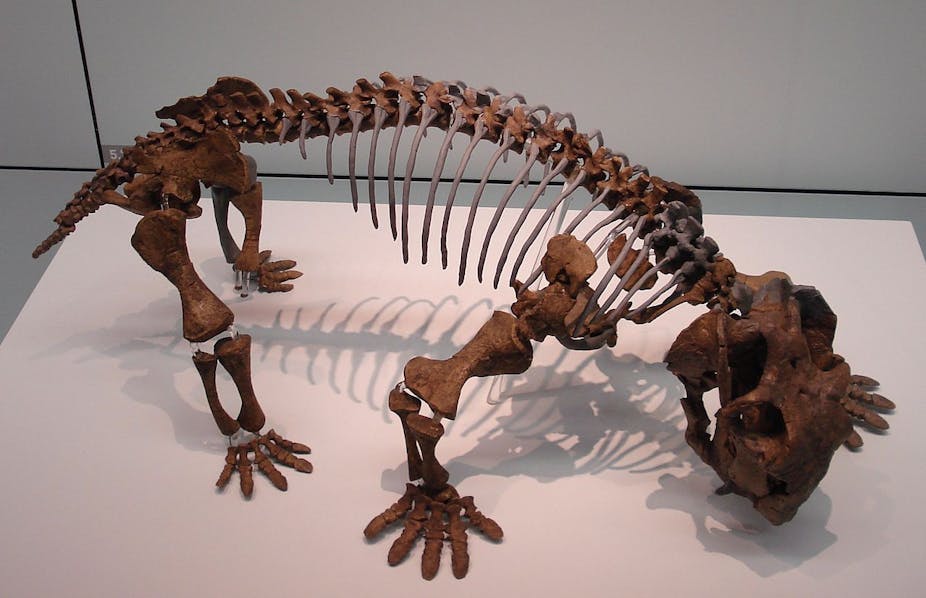There are more than 5,000 species of mammals alive today and most people would argue that they are some of the most successful animals on Earth.
But our research, published today, suggests that some mammals took a rather unexpected route when evolving into the beasts we know.
The success of mammals can be explained by three factors. They can can live in all habitats thanks to being warm-blooded, their behaviour is complex and adaptable thanks to their large brains and long period of parental care and their teeth are highly adaptable for a broad range of diets.
Mammals have a long history and a rich fossil record. The earliest known members of today’s three main mammalian groups date back to about 170 million years ago. However, much older mammal relatives are known.
These early “pre-mammals” are the synapsids, a group that covers all the stages of the anatomical transition from reptilian ancestors to furballs. Cynodonts are an especially intriguing group of synapsids, because they include the direct ancestors of mammals, and so might yield clues about how modern mammals came to be as successful as they are.

Cynodonts began to diversify shortly before the catastrophic end-Permian extinction, some 252 million years ago, and they thrived afterwards. Some were as small as 50cm long while others were as large as two metres. Some were carnivores and some were herbivores. Two major groups of cynodonts are known, the cynognathians and the probainognathians, and these show different ecological adaptations.
Know your pedigree
We decided to look at the evolutionary family tree of cynodonts to find out about the different paths these two groups took in their evolutionary story.
First, we assembled the most comprehensive evolutionary family tree of cynodont species, altogether encompassing their early history, a time span of more than 70 million years. This was a tremendous effort, requiring careful examination of databases and specimens in museum collections to add new information.
Assembling evolutionary trees is crucial for most, if not all, studies of patterns and processes of evolution: any major mistakes, and the later calculations may be worthless.

Our next step was to quantify the range of cynodont anatomical diversity. For this, we used analytical and statistical methods that look at the way in which different features of the cynodont skeleton can be coded, using these codes to measure the amount of anatomical divergence between and within groups of species.
We found that cynognathians and probainognathians do not differ much in terms of their anatomical diversity, although values for cynognathians were slightly higher. The disparity tends to fluctuate irregularly over time, though it was generally lower in the second half of our timeline than in the first half.
All change, but in different ways
Finally, we looked at the rates at which anatomical features evolved across cynodonts as a whole.
Cynognathians began with medium-large carnivores that experienced unusually high rates of anatomical change for a considerable portion of their history; they eventually evolved into several herbivorous and omnivorous lineages, but died out in the Late Triassic, 225 million years ago.
Probainognathians – which include the ancestors of modern mammals – were fairly small animals from the start, mostly of carnivorous and insectivorous habits. In contrast to the cynognathian, these early mammals went through rapid changes only at the beginning of their evolutionary history.
Probainognathians took to herbivorous habits as well, though much later in their history than cynognathians, when superficially rodent-like forms appeared, and a considerable slowing down in the rates of evolutionary change occurred. When we look at the entire group, we see that rates of change decreased steadily over time.
These results go against a generally held view that, with the beginning of the mammal radiation - when the diversification of mammals began to accelerate - and the accumulation of increasingly mammal-like traits in cynodont history, we might expect to detect a “burst” of evolutionary innovation.
At the very least, we expected that the earliest mammals would have stood apart from their ancestors, representing some kind of leap in new adaptations. However, they fell within the overall range of anatomical diversity of their forerunners, implying that mammals had their major burst of evolutionary innovation later in their history.
Our findings suggest that perhaps early mammal diversification went through two phases: an initial phase characterised by rapid evolutionary rates or “early burts” in the case of most cynognathians and early probainognathians, and a second, prolonged or “long fuse” phase for the more slowly evolving groups such as most probainognathians and earliest mammals.

